Political Theater: From Grim to Silly
Fed Big Shots Try to Still Waters of Dried Up Dam; Carbajal Under Fire for Armpit Remark

Political theatrics hit Santa Barbara hard this Thursday and from multiple directions at once. The regional director for the federal agency that owns Lake Cachuma — the Bureau of Reclamation — flew in from Washington, D.C., to soothe the fevered brows of water directors and water board members from all the water agencies drawing water off the dam, now down to its lowest level since 1953. At the same time, former Lompoc mayor John Linn and a troupe of about 20 Lompoc residents and their supporters descended on the congressional campaign offices of Salud Carbajal in downtown Santa Barbara, demanding that he apologize for referring to Lompoc as “the armpit of the county.”
Carbajal, in Washington, D.C., for campaign-related matters and to attend a speech by Hillary Clinton hosted by the Hispanic Congressional Caucus, issued an out-of-town apology. Of the two events, the dust-up over urban armpits was the most light hearted — despite the bombastic effrontery taken — and most likely to blow over soonest. The drought is, after all, the drought and no amount of spin can change that fact.
“When there’s no water, there’s no water for agriculture, there’s no water for M&I (municipal and industrial users), there’s no water for fish,” declared David Murillo, Bureau of Reclamation director of the Mid-Pacific Region. Murillo’s presence won’t guarantee the inundation of sudden rain, but it may have quelled some of the boiling animosity erupting between some of the water agencies that he says desperately need to cooperate.

The confab of water buffaloes that took place at Lake Cachuma Thursday afternoon was a far cry from the kumbaya fest hosted by Murillo’s deputy, Michael Jackson, two years ago at the same spot with the same group. Instead, this year’s was a display of collective rictus grin-and-bear-its issued by a gathering of high-octane technocrats bedeviled past the breaking point by circumstances beyond their control.
BODY POLITIX: To the extent there was any H2O to be had Thursday afternoon, Santa Barbara Supervisor Salud Carbajal found himself in it and it was hot, at least by Santa Barbara’s political standards. According to the Carbajal camp, the supervisor had been speaking privately with a personal friend who worked for the Santa Barbara County Association of Governments (SBCAG) during a break in a public SBCAG meeting held two weeks ago. She had recently moved to Lompoc, and Carbajal reportedly asked her, in joking fashion, how she liked living in “the armpit of the county.” The remark was reportedly overheard by Lompoc City Councilmember James Mosby, who then relayed it to conservative political activist and columnist Andy Caldwell of COLAB, who wrote an editorial blistering Carbajal late last week that appeared in the Santa Barbara News-Press.
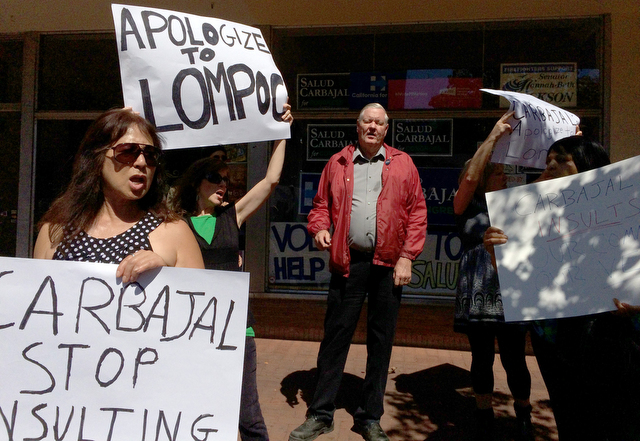
Not only was Carbajal insensitive for making such remarks, Caldwell charged, but the policies Carbajal has supported while supervisor has led to the economic emiseration of Lompoc and Santa Maria. Carbajal’s comment was then picked up by Cal Coast, a small online news source with a conservative slant, and then seized by the National Republican Congressional Committee.
This Thursday, Republican Party operatives alerted local media that John Linn was leading a charge on Carbajal‘s campaign headquarters accompanied by enough supporters — including a few Santa Barbara street people — to constitute a respectably sized throng for the TV news. “Salud Carbajal … Apologize now,” they chanted. “No more insults … no more corruption.”
CAN’T GET NO RESPECT: Linn, who is running for mayor again this November, sought to turn the remark into a slight on veterans in general, not just against the civic pride of Lompoc, which has been made the butt of jokes since W.C. Fields’s 1930s movie The Bank Dick. Linn also sought to link the slight to the terrorist attack of 9/11. “On September 11th of 2016, Supervisor Carbajal publicly mocked a woman who told him she moved from Santa Barbara to Lompoc,” declared a handbill Linn passed out. “Lompoc is a city known for military service and has one of the highest percentages of veterans of all cities in California,” it added. “It does NOT deserve to be ridiculed, especially by Mr. Carbajal who continues to MISREPRESENT his own military record.”
On an insult Richter scale of 1 to 10, Linn said Carbajal’s remarks rated a 7. “It could have been worse,” he said. “He could have called us the anus.” When asked what city could accurately be described as the county’s armpit, Linn answered, “Casmalia,” the site of a former toxic dump site and now an EPA Superfund clean-up project.

According to Carbajal’s campaign manager, Tess Whittlesey, Carbajal does not dispute having made the statement and said he expressed regret for having done so. Carbajal stressed the remark was made as a joke in a private conversation with a close friend with whom there’s a history of such ribbing. Whittlesey vehemently disputed, however, that the slight in question was issued on September 11, noting that 11th fell on a Sunday this year and Carbajal’s remarks took place at an SBCAG meeting. (Those traditionally take place on Thursdays.) She also disputed Carbajal in any way has misrepresented his military record. He served as a reservist with the Marines and was called up for active duty briefly in North Carolina. He never was deployed overseas, she said, nor did he ever state he was.
Whittlesey also said that Carbajal had been a strong supporter of Lompoc with his votes, noting he had backed funding as a supervisor to revitalize the Lompoc Veterans Building, among other things.
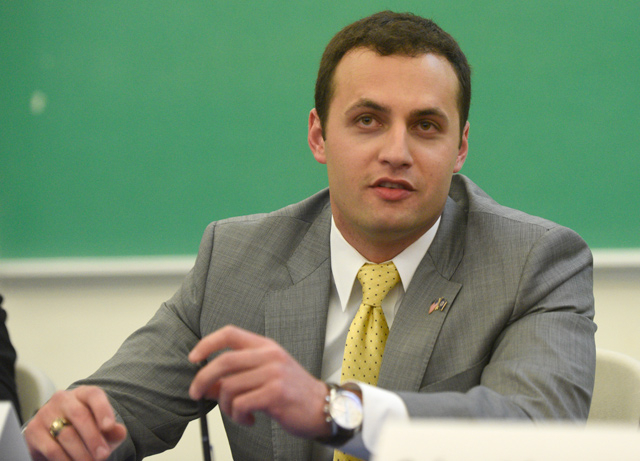
BACK STORY: Carbajal and Lompoc City Councilmember Mosby have crossed swords politically, and Mosby donated $1,000 to the congressional campaign of Carbajal’s Republican opponent, Justin Fareed. Since 2006, Mosby had leased out land he owns in Lompoc for soccer fields, football fields, a paint-ball range, and a remote-controlled-car race course. Given the agricultural zoning of the land, none of these uses are now legal nor were they in 2006. In 2014, Mosby came before the county supervisors seeking zoning changes that would have legalized such uses. Carbajal was part of the 3-2 majority to reject Mosby’s application. Carbajal spoke out against Mosby, arguing the county should not reward such violations with after-the-fact approvals simply because they’d taken place for eight years.
BAD BLOOD, NO WATER: Lake Cachuma — which typically supplies roughly half the water used by South Coast residents — is now only 7.5 percent full, yet another historic low. As grim as it is, that number appears more robust than it is. Of the 14, 468 acre-feet now in the lake, 12,000 are deemed off limits for human consumption so that the “lake” can maintain the minimal life support functions essential to any “lake.” Water agencies below the dam — Lompoc, Buellton, Solvang, and Santa Ynez — have traditionally feuded with those operating above Cachuma — Santa Barbara, Goleta, Montecito, and Carpinteria. But with water levels so abysmally low, fighting has broken out among even traditional upstream allies.
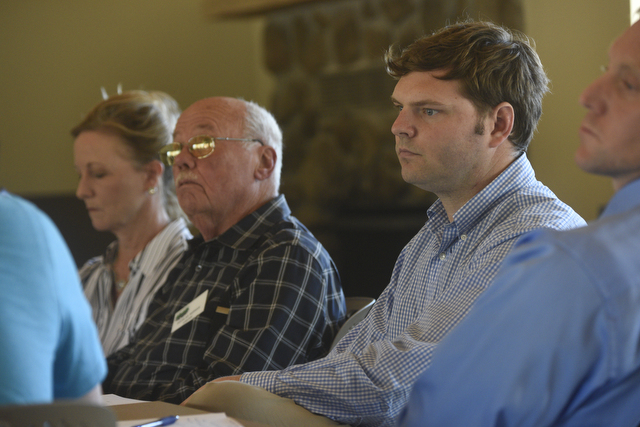
The water rights trial that broke out in court this week, for example, between Goleta Water District and “Law & Order” creator Dick Wolf — who owns Slippery Rock Ranch in the Goleta foothills — is in reality a proxy war between the Goleta district and the Montecito Water District, which triggered Goleta by expressing interest in purchasing water from Wolf’s Goleta ranch. That trial — with each side posting a phalanx of at least three expensive trial attorneys — threatens to run at least three weeks.
If mind-boggling technical reports on the bio-chemistry of Goleta’s hydro-geology were water, the state’s five-year drought would have been over yesterday. In a nutshell, Goleta is asserting it has first dibs on the water being pumped at Slippery Rock even though the two wells in question lie outside the perimeter of Goleta’s groundwater basin. Legally, that’s a bold claim, as California law recognizes the rights of property owners to any underlying water on their land. But Goleta is arguing that Slippery Rock’s wells are fed by subterranean flows which if left unimpeded — and untapped — would cascade down two nearby creeks into the Goleta plain and ultimately percolate into Goleta’s groundwater basin.
And that’s just the tip of the iceberg.
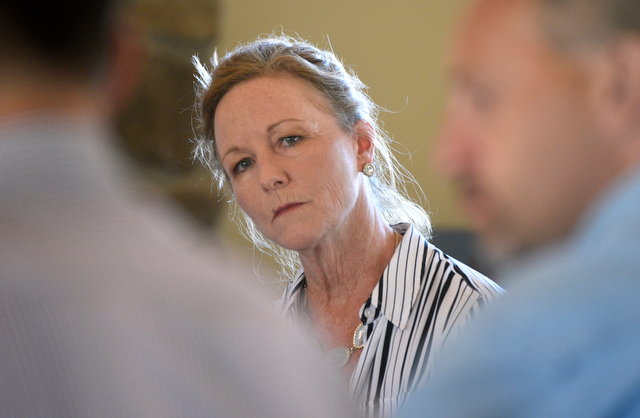
BAD COMB OVER: Further demonstrating the boiling over of bad blood, the Santa Ynez water district recently announced it was renouncing its membership in the Cachuma Operation and Maintenance Board (COMB), a superagency made up of six water agencies to do exactly what its name suggests. Santa Ynez has long maintained that the other five agencies have done more than required by federal regulators to take care of the endangered steelhead trout and that they have done so at the expense of its customers. That may or may not be true, but it probably doesn’t matter. That’s because just last week, the California Water Resources Control Board issued a 126-page edict notifying every operator on the Santa Ynez River that what they’ve been doing to preserve the steelhead has not been nearly good enough.
How much more water will have to be released for the steelhead to comply with that draft state order remains to be seen. But whatever it is, most everyone agrees, it won’t compare to the even stiffer requirements anticipated any day now from the federal agencies responsible for fish protection. Bottom line? The size of the ladle water agencies have been using to dip into the Santa Ynez just got a lot smaller and will get even smaller still before all is said and done.
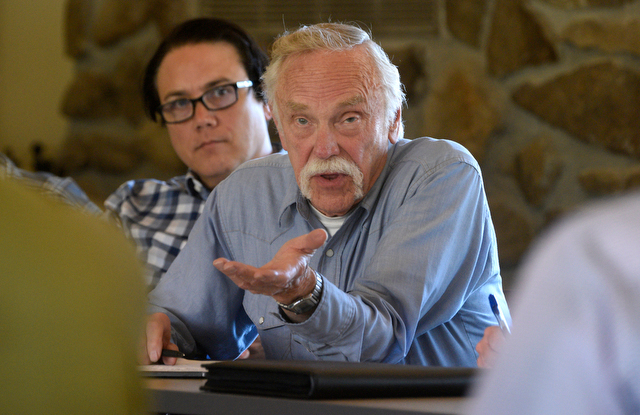
South Coast water agencies are still royally steamed they got legally hood-winked by agencies drawing water downstream from the dam this summer. Availing themselves to the ancient texts of obscure water contract language, downstream interests persuaded the Bureau of Reclamation to allow them to take 2,000 more acre-feet this summer in downstream releases than any of their upstream counterparts expected. (Such releases are required to keep downstream aquifers replenished so that communities — like Lompoc — that rely solely on groundwater wells are not left high and dry by Cachuma operations.) By the time upstream water managers knew what hit them, it was too late.
Downstream managers kept them in the dark on purpose, intentionally “hiding the football,” in the words of one Santa Ynez water sachem, for fear that Santa Barbara or Goleta would either “steal” the ball or “deflate” it. South Coast agencies were furious that Bureau officials never notified them that such a play was in the works. Bureau officials contend they believed Santa Ynez water officials had notified all concerned parties.
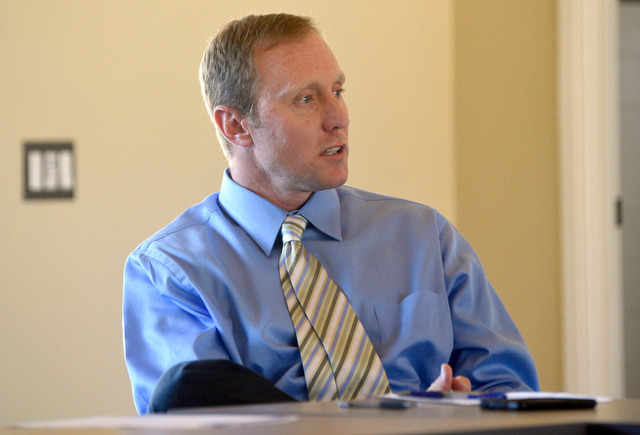
ALL STEAMED UP: It was this “failure to communicate” that helped inspire David Murillo, high ranking potentate with the Bureau of Reclamation, to schedule a quick, almost last-minute visit to Santa Barbara to host a sit-down session with representatives from all the water agency directors and as many board members as cared to attend. Murillo clearly showed up ready to listen, but the first several water agency reps spent much of their time expressing “appreciation” that Murillo dignified their gathering and extolled the virtues of “collaboration.” Murillo sought to get things going, telling the group, “We need to take something away from this meeting. If not, we can just meet, go our own way, and nothing’s going to happen.”
That helped. Joshua Haggmark, water czar for the City of Santa Barbara, got specific. What could Murillo do to help get a federal emergency declaration enacted? And would that free up any federal money that could offset some of the costs of the city’s desalination plant — $55 million already and another $45 million potentially down the road? Murillo answered that a state emergency declaration needed to take place first. He did note, however, that his agency had $100 million in drought project funding available this year for California and urged those attending with “shovel ready” projects to get their applications submitted.
When Haggmark grumbled obliquely about being kept in the dark about this year’s downstream releases, Murillo asked him directly, “Is there an issue with communication?” After Haggmark responded about his level of “surprise,” Bureau deputy Michael Jackson intervened, stating, “What Joshua is saying is he would have appreciated knowing sooner rather than later.”
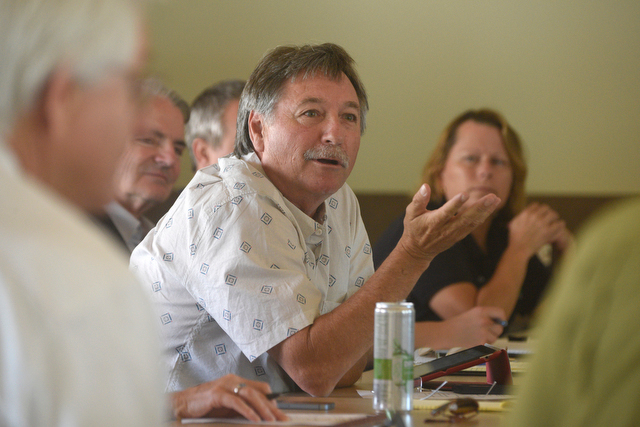
FEED THE FISH: The 8,000-pound gorilla in the room was the steelhead trout, and more precisely, how much water would have to be released to bring the endangered species back from the brink of extinction. Santa Ynez water czar Chris Dahlstrom, was outspoken in his criticism of the program. How much water, he asked, was released down the main stem of the Santa Ynez River for the steelhead only to have the steelhead munched by nonnative invasive predator fish like the bass planted in the lake decades ago for sport fishing?
Murillo stressed how he had gone to bat for many water agencies across the state against federal regulators looking out for the fish. There were other ways to help endangered species, he stressed, than just releasing more water. But — and this was perhaps his main point — he stressed that water agencies needed to have a clear unified voice when dealing with the federal agencies responsible for fish protection. As the new fish protection rules are promulgated, none of the water agencies drawing from the Santa Ynez River are allowed a seat at the bargaining table. The Bureau of Reclamation, however does. Again, Murillo’s message was clear: Quit fighting among yourselves, speak with one voice, and I’ll represent you.
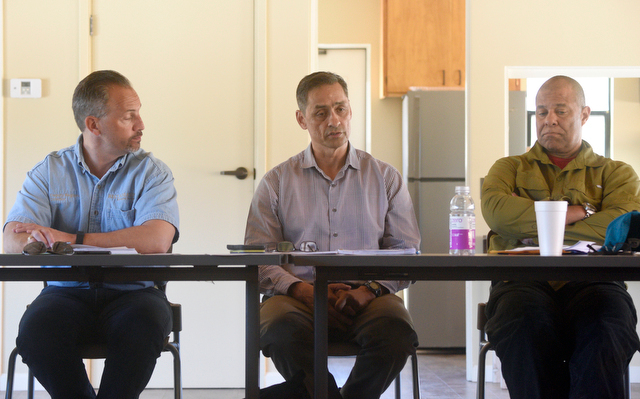
The last word of the day went not to Murillo, but to his deputy Michael Jackson, the real point person in the Bureau with whom Santa Barbara water agencies interact. In years past, Jackson had been blasted by previous COMB administrators after several water pumps that fed Hilton Creek with water to keep remnant steelhead alive malfunctioned. When CalTrout sued the Bureau over that, no one was surprised. But when COMB itself joined that lawsuit, just about everyone involved in the river was flabbergasted.
In person, Jackson projects a cheerful, good-natured demeanor. No doubt, it’s who he is; it’s also professional body armor. The meeting agenda described Jackson’s presentation as “The Value of Relationships.” When in doubt, Jackson urged those in attendance, try to be nice. “If you can say something that can convey your feelings that can maintain your relationship or does not damage your relationships, I would strongly suggest you do that,” he said. “You’re not required to be courteous. There’s no law that says you have to be courteous. But it sure helps.”



